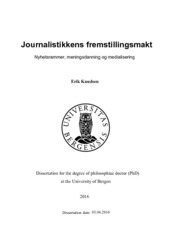| dc.description.abstract | This book addresses three core aspects of the literature within communication science: 1) how journalists frame stories in the news, 2) the effects of such frames on citizen’s attitudes, and 3) how such frames can contribute to the mediatization of institutions in society. Although previous research has thoroughly investigated each of these aspects separately, none have aimed to integrate these aspects. Thus, we do not yet fully understand how these aspects should be understood in relation to each other. Mindful of this, I suggest an integrated approach to the study of the relation between news framing, framing effects and mediatization. The concepts of framing and mediatization have virtually developed as two separate research schools. One of the central arguments of this dissertation is that the two concepts have a great deal in common and thus could benefit from learning from each other. Although previous research has alluded to such connections, this book contributes to the literature by suggesting how the two bodies of literature can be further integrated. Empirically, the dissertation aims to demonstrate how such a connection can be made through integrated studies of news framing in press coverage (framing in content), effects on public opinion (framing effects), and effects on an institution (mediatization). I do this by 1) a longitudinal content analysis of how journalists frames a Norwegian public sector organization in press coverage; 2) surveys and a survey experiment of the effects of journalistic framing on citizens attitudes towards the public bureaucracy; and 3) qualitative interviews and statistical time series analysis of how the public bureaucracy relates, adopts and is effected by the journalistic framing. In the content analysis I investigate framing, tone and source use in five Norwegian newspapers’ coverage of the public bureaucracy. An important contribution in this regard, is that I identify a relationship between journalistic emphasizing on human interest frames and negativity in stories about the public bureaucracy. In the analyses of the public opinion surveys, I investigate differences in opinions among citizens with direct and indirect experiences with the public bureaucracy. Interestingly, the analyses show that people are more likely to report a negative attitude toward the organization if they have indirect (such as media coverage), rather than direct, experiences with the public bureaucracy. The survey experiment investigates how news frames (human interest/episodic or thematic) and valance (negative or positive) influences people’s attitudes. The results suggest that a combination of human interest stories and negative valance in news stories about the bureaucracy is especially likely to cause people to direct negative attitudes towards the organization. The analyses of how the public bureaucracy is influenced by media framing show that the public organization has altered their confidentiality policy—permitting the organization to break confidentiality—to counter news stories that emphasizes human interest stories and negativity. Moreover, the results from the time series analyses suggest that the negative news coverage influences the public bureaucracy’s effectivity. Together, these studies illustrate that journalistic framing can influence both people’s attitudes and institutions. Theoretically, the integrated studies in this dissertation thus contribute to the existing literature on framing and mediatization, by 1) showing how news frames can help explain why institutions in society adopt the media’s logic; and 2) extending our understanding of framing effects, from mainly effects on attitudes and behaviour, to also include effects on institutions. | en_US |
